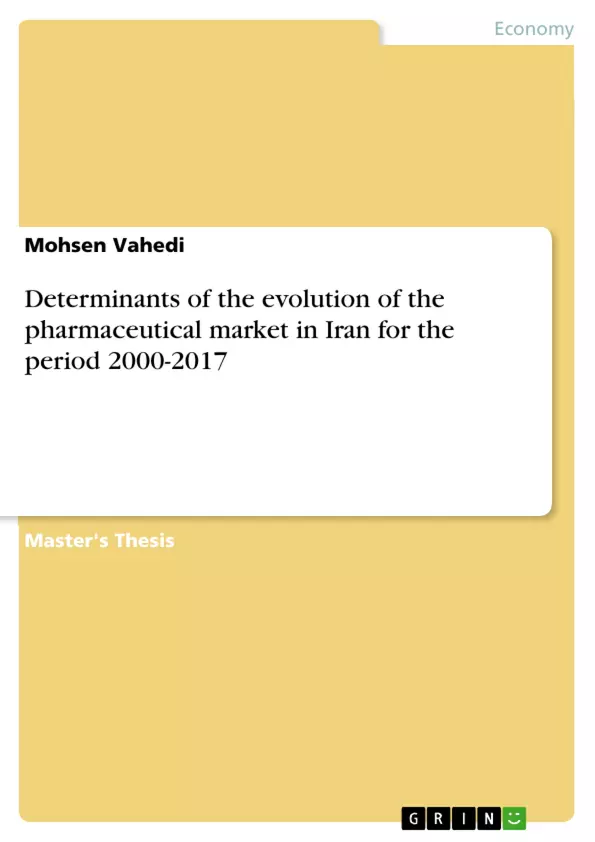This research paper analyses the determining factors in the development of Iran's pharmaceutical market, which was favoured by economic reforms and the economic boom caused by globalisation since the 1990s. In addition to a detailed analysis of the structure of the Iranian pharmaceutical market and of the industrial and commercial policies applied to this sector, this research includes an empirical application that aims to identify the determinants of the evolution of the market between the years 2000 and 2017. For this, a multivariate model is used, complemented by the method of the Impulse Response Function. The results indicate that, in Iran, foreign currency from oil revenues continues to be an essential determinant in the development of the domestic industry and the importation of high-cost products during our study period. On the other hand, we corroborated that, although social expenditures tried to sustain the market during the period of application of the sanctions imposed on Iran, the market shows signs of vulnerability to shock and the fall of imports due to difficulties in trade. Finally conclude that the non-oil exports which have been increasing during the period of study are the new sources of foreign exchanges for imports of medicines.
Inhaltsverzeichnis (Table of Contents)
- 1. INTRODUCTION
- 2. AN OVERVIEW OF PHARMACEUTICAL POLICIES IN DEVELOPING COUNTRIES
- 3. PHARMACEUTICAL INDUSTRY AND MARKET IN IRAN: EVOLUTION AND STRUCTURE
- 3.1. Evolution of the pharmaceutical market: industrial policies and changes in domestic production
- 3.2. Trade policies: effect on the import of medicines
- 3.3. Industrial organisation of the Iranian pharmaceutical sector: structure and concentration
- 4. DETERMINANTS IN THE IRANIAN PHARMACEUTICAL MARKET: A QUANTITATIVE TEST
- 4.1. Background and hypothesis
- 4.2. Method and definition of variables
- 4.3. Results
- 5. CONCLUSIONS
- 6. REFERENCES
Zielsetzung und Themenschwerpunkte (Objectives and Key Themes)
This research aims to analyze the factors that have influenced the evolution of the pharmaceutical market in Iran. The study focuses on the period between 2000 and 2017, a time marked by economic reforms and the effects of globalization on the country. The research utilizes a multivariate model and Impulse Response Function to understand the market's development.
- Evolution of the pharmaceutical market in Iran
- Impact of industrial and commercial policies on the pharmaceutical sector
- Role of oil revenues and international sanctions in the market's development
- Analysis of domestic production and import of medicines
- Impact of social expenditures and non-oil exports on the pharmaceutical market
Zusammenfassung der Kapitel (Chapter Summaries)
- Chapter 1 provides an introduction to the research, highlighting the significance of the pharmaceutical sector in developing countries and its connection to economic growth. It specifically focuses on Iran, analyzing the pharmaceutical industry's role in diversifying the economy despite challenges related to dependence on oil revenues.
- Chapter 2 explores the theoretical framework of industrial policies in developing countries and their impact on the growth of the pharmaceutical sector. It analyzes key factors influencing this growth, including national policies, economic context, and competitive market forces.
- Chapter 3 dives into the reforms and policies implemented in Iran since the 1990s, detailing the main features of the pharmaceutical market and its industrial organization. It analyzes the evolution of the market, trade policies, and the structure and concentration of the Iranian pharmaceutical sector.
- Chapter 4 introduces a quantitative model to analyze the Iranian pharmaceutical market between 2000 and 2017. The chapter outlines the background, hypothesis, methodology, definition of variables, and results of the research.
Schlüsselwörter (Keywords)
The research centers on the Iranian pharmaceutical market, analyzing its evolution and determinants. Key concepts include industrial and trade policies, oil revenues, international sanctions, domestic production, import of medicines, and social expenditures. The study also focuses on the impact of non-oil exports on the market's development.
- Quote paper
- Mohsen Vahedi (Author), 2020, Determinants of the evolution of the pharmaceutical market in Iran for the period 2000-2017, Munich, GRIN Verlag, https://www.grin.com/document/920602



